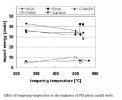I'm pretty sure there are only 3 on that list that hit >40J at 59 to 62 HRC: 3V, 4V, and Vanadis 4E.
Lateral strength is pretty important, too. I'm not talking about prying. I'm talking about toughness to resist cracking and chipping, strength to resist rolling/ plastic deformation (not just hardness alone), and wear resistance. Very few steels meet that combination. Off the top of my head the only steels that can meet those three in one package are 3V at 58 to 60, 4V/V4E at 58 to 61, and maybe cruwear at 60 to 62 HRC. 4V/V4E at that hardness having the highest abrasive and adhesive wear resistance while still having appropriate levels of strength and toughness. Put A11 in a cutting test with soft, abrasive material and it'll come out ahead. Put S7 in a chopping test and it'll come out ahead. Put 4V/V4E in an everyday test where various and wide ranging media needs to be cut in less than ideal circumstances, I honestly believe it'll come out on top, followed by 3V/Z-Wear/Cruwear/PD1, then M4, with M4 and the 3V class running neck and neck for utility work, ie, sometimes you need toughness and strength, sometimes you need wear resistance.
I don't believe many, if any, stainless steels can take the amount of hard work as the aforementioned tool/carbon steels while still retaining a good to excellent edge. Correct me if I'm wrong, but I'm pretty sure M390 has <=half the toughness of 4V at the same hardness and about the same as M4, but with less wear resistance than M4.
Don't get me wrong, it's quite probably true that M390 and Elmax are some of the toughest and strongest stainless knife steels that still have very good to excellent wear resistance, but they don't hold much water, pun intended, compared to the 3V/4V classes cutting a wide assortment of media using harsh cutting methods.
Please refer to my ZT 0180 Hard Use Test. There was very little edge damage after cutting random media that would have wrecked a lot of other steels. I don't have calipers or I'd measure the thickness behind the edge. It's not ridiculously thick. ZT has never been accused of being the best in heat treating their steels. I can only imagine what an all purpose utility knife with 4V/V4E steel heat treated by someone like Phil Wilson would do.
The real problem is there's no way to test for everyday utility work without pushing a knife beyond its capabilities and ruining its value due to irreparable damage. Charpy test damage can be repaired. Rockwell test damage can be repaired. Cardboard cutting damage can be repaired. And on top of that, those tests can all be replicated. The fact, though, is that they're not helpful in determining the best all around steel for knives meant to work hard unless all of those test results are available from neutral third parties and they're not.
Buddy, of course carbon steels are implicitly tougher, but in my more than thirty years long knife usage I've seen more than a epic failure fro Carbon Steels in the form mainly of pitting rust. 3V is a very good steel IF you're NOT facing heavily damp or chlorinated environments. Lot of trekking I did in Tuscany no far than 3km as the crow flies from the seashore, when water with me was meant to be drunk and not to clean my knife. Getting an PVD or passivated 3V was meaning to break my bank vault. The classic no no.
CPM-M4 and equivalents are quite quite better (ask Surferingo) and I did already explain why, obviously quitting some toughness. But if you compare 3V, 4V and CPM-M4 into the 4V datasheet you can easily get the Whole picture: i.e. 4V has some sense when at 62 (when as a side effect Cr carbides will be nil and all Moly will be available for pitting resistance). Even at that level edge holding won't be any close to CPM-M4 at same hardness, toughness will be 49J against 43J and stain/pitting resistance way less.
Elmax has 43J at 63 with a CERTAIN HT procedure that drops retained cementite to nil.
M390 has 43J when low tempered, always with a CERTAIN HT.
Reference: Institute of Metallurgy of Zurich (6th International Tooling Conference)
[et infra the publication REFERENCES]
[1] G. Hackl, H. Lenger, J. Sammer, H. Makovec:"Pulvermetallurgische Herstellung,
Gef¨ugezust¨ande und Eigenschaften des h¨ochstlegierten, korrosionbest¨andigen Kunststoffformenstahles
B¨OHLER M390 ISOMATRIX", BHM 140, 1995, H.1, p.68
[2] R. Breitler, J. Mayerhofer:"Superclean tool steel for TV-panel production", Proc.4 th
International Conference on Tooling, Ruhr-Universit¨at Bochum, 1996, p.287
[3] H. Ian, J. Sammer, M. Gstettner, K. Leban, I. Jung:"B¨OHLER M340 - A new development
in the field of corrosion resistant plastic mould steels" Proc.4 th International
Conference on Tooling, Ruhr-Universit¨at Bochum, 1996, p.297
[4] G. Lichtenegger, R. Schneider, J. Sammer, G. Schirninger, P. W¨urzinger, J. Neuherz:
"Development of a nitrogen alloyed tool steel" Proc. 5th International Conference on
Tooling, University of Leoben, Austria, 1999, p.643
[5] ASTM G65, current edition Oct.,1981
Worth mentioning that in all of this literature toughness is the lateral one.
So, my neck knife is 3V, my EDC knives are S30V/S35VN/S125V/CPM-M4/M390 (customs) none of them below 61 and CPM-M4/M390 beyond 63, S125V only is kept at 0.026"TBE and 20° per side, the others well below in both values.
No edge turning, chipping, breaking inso far.

